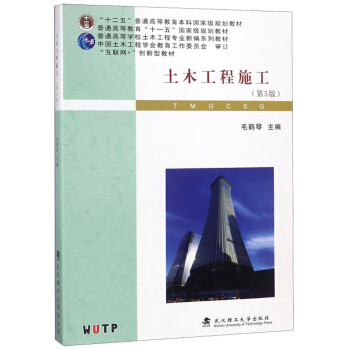Construction Materials土木工程材料
作者: 李宗津
出版时间:2014年8月
出版社:中国建筑工业出版社
- 中国建筑工业出版社
- 9787112170531
- 1-1
- 47972
- 0047162664-8
- 平装
- 16开
- 2014年8月
- TU5
- 土建类
- 本科
Chapter 1 Introduction
1.1 Historic development
1.2 Structural materials and structural design
1.3 Physical properties
1.3.1 Density, apparent density and packing density of matter
1.3.1.1 Density
1.3.1.2 Apparent density
1.3.1.3 Packing density
1.3.2 Porosity and void percentage
1.3.2.1 Porosity
1.3.2.2 Void percentage
1.3.3 Physical properties relevant to water
1.3.3.1 Hydrophilicity and hydrophobility
1.3.3.2 Water adsorption
1.3.3.3 Hygroscopicity
1.3.3.4 Water resistance (coefficient of softening)
1.3.3.5 Water impermeability
1.3.3.6 Frost resistance
1.3.4 Physical properties relevant to thermal effects
1.3.4.1 Thermal conductivity
1.3.4.2 Thermal capacity and specific heat capacity
1.3.4.3 Thermal expansion
1.3.4.4 Fire resistance and refractoriness
1.4 Chemical properties
1.4.1 Reactivity
1.4.2 Activation energy
1.5 Principles in the selection of materials
1.6 Innovations and development trends in construction materials
1.6.1 Functional materials
1.6.1.1 Cement-based piezoelectric materials
1.6.1.2 Thin-walled low frequency sound shielding material
1.6.1.3 Controllable heat insulation building products with phase changing materials (PCM)
1.6.1.4 Electromagnetic wave shielding and absorbing materials
1.6.2 Sustainability..Eco-friendly material development
1.6.2.1 Recycle and reuse of industry waste
1.6.2.2 New binders-energy efficient materials with less COe
1.6.3 Multiple disciplinary integrated materials
1.6.3.1 Nanotechnology in construction
1.6.3.2 Dynamic shading window system (DSWS)
1.6.3.3 Self-compacting concrete (SCC)
Discussion topics
References
Chapter 2 Mechanical behavior of materials
2.1 Material behavior and structural performance
2.2 Elastic behavior
2.2.1 Introduction
2.2.2 Physical basis of elastic behavior
2.2.3 Young's Modulus: definition, typical values and significance to structural design
2.2.4 Modulus of composite materials and application to reinforced concrete member
2.3 Plastic behavior
2.3.1 Phenomenon of plastic yielding
2.3.2 Physical basis of plastic behavior
2.3.3 Modeling of plastic behavior
2.3.4 Illustration of plastic behavior with a parallel system
2.4 Time dependent behavior--Creep
2.4.1 Phenomenon of time dependent behavior
2.4.2 Implications to structural design
2.4.3 Physical basis of time dependent behavior
2.4.4 Modeling of creep at low temperature with viscoelastic models
2.4.5 Strain response under arbitrary stress history superposition
2.5 Fracture
2.5.1 Introduction
2.5.2 Fast fracture: physical basis and modeling
2.5.3 Ductile to brittle failure transition of metal
2.5.4 Fatigue--phenomenon and empirical expressions
2.5.5 Physical basis of fatigue and K-based modeling
Discussion topics
Problems
References
……
Chapter 3 Aggregates
Chapter 4 Binder materials
Chapter 5 Concrete
Chapter 6 Steel
Chapter 7 Fiber reinforced polymer composites
Chapter 8 Wood
Chapter 9 Pavement materials
Chapter 10 Major non-structural materials
Construction Materials Laboratory
Index
















